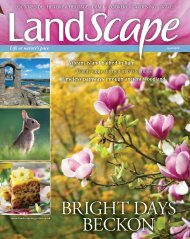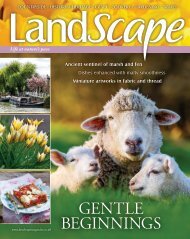You also want an ePaper? Increase the reach of your titles
YUMPU automatically turns print PDFs into web optimized ePapers that Google loves.
STILL ONLY £1.99! PLUS FREE SEEDS<br />
<strong>July</strong> 1, 2017<br />
£2.99!<br />
worth<br />
FREE<br />
SEEDS<br />
£2.99!<br />
worth<br />
Britain's<br />
most trusted<br />
voice in<br />
gardening<br />
Carol Klein<br />
'Grow foxgloves<br />
for height and<br />
drama'<br />
Chop now<br />
for more<br />
dahlia blooms!<br />
GET A SWATHE<br />
OF COLOUR WITH<br />
SALVIA NEMOROSA<br />
Guarantee a<br />
bumper crop<br />
of tomatoes<br />
5<br />
Silver-leaved<br />
stunners to<br />
add sparkle<br />
Ramp up<br />
the flower<br />
POWER!<br />
● Head-turning hanging baskets<br />
● Lofty plants to boost borders<br />
● Best bulbs for late colour<br />
Keep shrubs healthy<br />
through summer
4 ISSUES OF Don’t miss our essential weekly advice and<br />
Pinch out the growing points of each stem once the second pair of leaves has opened to<br />
encourage bushier growth.<br />
Pick flowers frequently for a long and regular supply of blooms.<br />
Growing Instructions: Hardy annual. Sow sweet pea seeds indoors in October for<br />
transplanting outdoors in spring, or sow directly outdoors in March or April. If sowing<br />
in autumn, sow three seeds per 7.5cm (3in) pot at a depth of 1cm (1/2in) in good quality<br />
seed compost. Place in a propagator at a temperature between 20 and 25C (68-77F)<br />
or put inside a plastic bag. Once germinated, grow on in cooler conditions before<br />
transferring to a cold frame for overwintering. Plant out in spring once all risk of frost<br />
has passed at 23cm (9in) apart. Alternatively sow directly outdoors in March or April in<br />
rows at a depth of 2.5cm (1in) and 7.5cm (3in) apart.<br />
200cm<br />
(6 1/2ft)<br />
30cm (12in)<br />
OFFER CLOSES December 31 2017<br />
• A mix of white, pink, red, blue, purple, bicolours and stripes<br />
• Large and fragrant flowers<br />
• Grow against walls or fences<br />
4 ISSUES OF Don’t miss our essential weekly advice and<br />
Growing Instructions: Hardy Annual. Sow seeds on the surface of a good seed<br />
compost, then cover lightly with a sprinkling of compost or vermiculite. Place the seed<br />
tray in a propagator at a temperature of 20–25C (68–77F) or seal inside a polythene<br />
bag. Keep soil moist but not wet. Do not exclude light as this helps germination, which<br />
usually takes 21–30 days. Transplant seedlings when they are large enough to handle,<br />
and grow on in cooler conditions. When plants are well grown and all risk of frost has<br />
passed, acclimatise to outdoor conditions over 7 to 10 days. Plant in any well-drained<br />
soil in full sun, 30cm (12”) apart.<br />
tips, written by gardeners for gardeners.<br />
or call<br />
Sow outdoors Sow indoors Plant out Flowers<br />
50cm<br />
(20in)<br />
45cm (18in)<br />
OFFER CLOSES December 31 2017<br />
Growing Instructions: Hardy biennial. Sow seed on free-draining, damp seed<br />
compost and cover with a fine sprinkling of compost or vermiculite. Place in a<br />
propagator or seal container inside a polythene bag at 15–20C (59–68F) until after<br />
germination, which usually takes 14–30 days. Do not exclude light, as this helps<br />
germination. Transplant seedlings into trays or 7.5cm (3in) pots. Grow on in cooler<br />
conditions for 10–15 days before planting out, 60cm (24in) apart. Always ensure good<br />
drainage, and mulch with compost in autumn. Can also be sown where they are to<br />
flower, 1.5mm deep, in rows 30cm (12in) apart. Thin out to 60cm (24in) apart.<br />
www.greatmagazines.co.uk/seeds<br />
4 ISSUES OF Don’t miss our essential weekly advice and<br />
Bees love these bell-shaped flowers.<br />
This foxglove self-seeds and will quickly colonise a border. Looks beautiful when grown<br />
grouped together in this way. Plants can be toxic if eaten.<br />
120cm<br />
(4ft)<br />
tips, written by gardeners for gardeners.<br />
Coreopsis adds vibrancy to cottage, wildlife and cut-flower gardens.<br />
Deadhead faded blooms to prolong flowering.<br />
0844 848 8872 quoting ref SE17<br />
•Fabulous delicate, multicoloured flowers<br />
•Sow in drifts for blocks of long-lasting, vibrant colour<br />
• Compact and neat, perfect for bed and border edges<br />
• Easy to grow with masses of large, elegant, pure white flower spikes<br />
• Loves shady beds and borders, where this foxglove will self-seed<br />
• Perfect for pollinators – and for wildlife and cottage gardens<br />
1m (40in)<br />
Promotional packet – not for resale. Sow by Dec 2017.<br />
Average content: 150 seeds<br />
OFFER CLOSES December 31 2017<br />
Go online at<br />
or call<br />
FOXGLOVE<br />
J F M A M J J A S O N D<br />
Go online at<br />
Sow indoors Plant out Flowers<br />
‘Alba’<br />
or call<br />
Sow indoors Plant out Flowers<br />
FOR JUST £1<br />
Enjoy your best-ever summer<br />
£1<br />
Subscribe for just...<br />
NEW EASY-USE PACKET! Simply snip & pour...<br />
‘Cambridge Blue’<br />
NEW EASY-USE PACKET! Simply snip & pour...<br />
SWEET PEA<br />
‘Fragrantissima’<br />
LOBELIA ERINUS<br />
Large fragrant fowers<br />
Excellent garden performance<br />
www.greatmagazines.co.uk/seeds<br />
08448488872 quoting ref SE15<br />
OFFER CLOSES December 312017<br />
4 ISSUES OF Don’t miss our essential weekly advice and<br />
Don’t miss out on this fantastic offer, subscribe today!<br />
01858 438884 or www.greatmagazines.co.uk/gn<br />
tips, written by gardeners for gardeners.<br />
Go online at<br />
Promotional packet – not for resale. Sow by June 2018.<br />
Average content: 1000 seeds<br />
Growing Instructions: Half hardy annual. Sow seed on the surface of a good seed<br />
compost and gently firm down. Place the seed tray in a propagator at a temperature<br />
between 18 and 24C (65-75F) or seal inside a polythene bag. After sowing, do not<br />
exclude light, which helps with germination. Keep the surface of the compost damp,<br />
but not wet. Germination usually takes 14 to 21 days. Transplant seedlings when large<br />
enough to handle and grow on in cooler conditions. When all risk of frost has passed,<br />
gradually acclimatise plants to cooler conditions over 7 to 10 days before planting out in<br />
a sunny or semi-shaded spot in well-drained soil at 10cm (4in) apart.<br />
Print<br />
n 6 monthly Direct Debit £26<br />
n Annual Direct Debit £52<br />
BEST OFFER! £1 AN ISSUE!<br />
n Annual Credit / Debit Card<br />
/ PayPal £63<br />
<strong>Digital</strong><br />
n 6 monthly Direct Debit £24.50<br />
n Annual Direct Debit £49<br />
n Annual Credit / Debit Card<br />
/ PayPal £49<br />
10cm<br />
(4in)<br />
www.greatmagazines.co.uk/seeds<br />
0844 848 8872 quoting ref SE15<br />
• A compact variety with sky-blue flowers<br />
• An easy-to-grow annual popular for its versatility and long flowering period<br />
• Ideal for beds, containers and window boxes<br />
tips, written by gardeners for gardeners.<br />
Go online at<br />
Keep well watered, especially during hot, dry weather.<br />
Feed frequently over summer to provide an endless supply of blooms.<br />
15cm (6in)<br />
WORTH<br />
£<br />
2 .49<br />
Promotional packet – not for resale. Sow by June 2018.<br />
Average content: 35 seeds<br />
COREOPSIS<br />
or call<br />
LOBELIA ERINUS<br />
J F M A M J J A S O N D<br />
‘Cambridge Blue’<br />
FOR JUST £1<br />
SWEET PEA<br />
WORTH<br />
£<br />
2 .99<br />
J F M A M J J A S O N D<br />
NEW EASY-USE PACKET! Simply snip & pour...<br />
‘Fragrantissima’<br />
FOXGLOVE<br />
‘Alba’<br />
NEW EASY-USE PACKET! Simply snip & pour...<br />
‘Incredible Dwarf Mix’<br />
Cool blooms for shady spots<br />
Masses of multicoloured blooms<br />
www.greatmagazines.co.uk/seeds<br />
0844 848 8872 quoting ref SE17<br />
Promotional packet – not for resale. Sow by June 2018.<br />
Average content: 100 seeds<br />
Sow indoors Plant out Flowers<br />
FOR JUST £1<br />
WORTH<br />
£<br />
2 .29<br />
WORTH<br />
£<br />
2 .99<br />
Quote reference when ordering EDAA<br />
Open to both new and renewing subscribers<br />
YES, I would like to subscribe to <strong>Garden</strong> <strong>News</strong><br />
YOUR DETAILS<br />
YES, please extend my subscription<br />
YOUR Title YOUR DETAILSInitial Surname<br />
Address Title<br />
Title Address<br />
Initial<br />
Initial<br />
Surname<br />
Surname<br />
Address<br />
Postcode<br />
Email*<br />
Postcode<br />
Telephone Email*<br />
Postcode Mobile*<br />
Telephone Email*<br />
Mobile*<br />
*Please enter this information so that Bauer Media Group (publishers of this magazine) can keep you<br />
up-to-date Telephone by email and free mobile messaging with Mobile* fantastic offers and promotions. We promise<br />
that *Please you can enter unsubscribe this information any so time that if Bauer you don’t Media find Group them (publishers interesting of and this you’ll magazine) only get can messages keep you<br />
about up-to-date<br />
*Please things enter we’ve by<br />
this<br />
email chosen information<br />
and especially free<br />
so<br />
mobile<br />
that for Bauer<br />
messaging you from Media ourselves with<br />
Group<br />
fantastic<br />
(publishers and our offers network of<br />
and<br />
this<br />
promotions. of magazine) great partners can<br />
We<br />
keep whose promise<br />
you<br />
products that<br />
up-to-date<br />
you and can<br />
by services unsubscribe<br />
email and we think free<br />
at any you’ll mobile<br />
time enjoy. messaging<br />
if you don’t<br />
with<br />
find them<br />
fantastic<br />
interesting<br />
offers and<br />
and<br />
promotions.<br />
you’ll only get<br />
We<br />
messages<br />
promise<br />
about<br />
that you<br />
things<br />
can<br />
we’ve<br />
unsubscribe<br />
chosen<br />
at<br />
especially<br />
any time<br />
for<br />
if you<br />
you<br />
don’t<br />
from ourselves<br />
find them<br />
and<br />
interesting<br />
our network<br />
and you’ll<br />
of great<br />
only<br />
partners<br />
get messages<br />
whose<br />
products<br />
about things<br />
and<br />
we’ve<br />
services<br />
chosen<br />
we think<br />
especially<br />
you’ll enjoy.<br />
for you from ourselves and our network of great partners whose<br />
products and services we think you’ll enjoy.<br />
DELIVERY DETAILS (if different, i.e. purchased as a gift).<br />
DELIVERY DETAILS (if different, i.e. purchased as a gift).<br />
Title DELIVERY DETAILS Initial (if different, Surname i.e. purchased as a gift).<br />
Address Title Initial Surname<br />
Title Address Initial Surname<br />
Address<br />
Postcode<br />
Email<br />
Postcode<br />
Telephone Email<br />
Postcode<br />
‘Incredible Dwarf Mix’<br />
COREOPSIS<br />
J F M A M J J A S O N D<br />
FOR JUST £1<br />
PLUS<br />
Get more than<br />
£100<br />
worth of<br />
FREE SEEDS<br />
over the year!<br />
AN issue!<br />
When you choose the print option and pay by Direct Debit<br />
If you’ve enjoyed reading this issue of<br />
<strong>Garden</strong> <strong>News</strong> why not subscribe? It’s the<br />
only gardening magazine you’ll ever need<br />
as it’s packed full with practical advice and<br />
inspirational ideas on what to do in your garden<br />
each week. It’s also convenient as your copy will be delivered<br />
straight to your door or digital device each week. This special<br />
subscription price will save you money – a genuine bargain!<br />
SEND TO: Please include completed coupon and cheque (if appropriate) with the magazine name on the back<br />
Magazine subscriptions, FREE POST, EDO3995, Leicester LE16 9BR<br />
Originator’s Identification Number<br />
Originator’s 7 2 4Identification 0 9Number<br />
6<br />
Originator’s Identification Number<br />
7 2 4 0 9 6<br />
Account Name<br />
Account Name<br />
Account Number<br />
Account Name<br />
Account Number<br />
Sort Code<br />
Account Number<br />
Sort Code<br />
Name Sort Code and Address of Bank<br />
Name and Address of Bank<br />
Name and Address of Bank<br />
Postcode<br />
Simon Caney<br />
Editor<br />
Please pay Bauer Consumer Media Direct Debits<br />
from the account detailed in the instructions (subject<br />
to Please the safeguards pay Bauer of Consumer the Direct Media Debit Direct Guarantee). Debits<br />
from<br />
Please<br />
the<br />
pay<br />
account<br />
Bauer<br />
detailed<br />
Consumer<br />
in the<br />
Media<br />
instructions<br />
Direct Debits<br />
(subject<br />
to<br />
from<br />
the<br />
the<br />
safeguards<br />
account detailed<br />
of the Direct<br />
in the<br />
Debit<br />
instructions<br />
Guarantee).<br />
(subject<br />
to the safeguards of the Direct Debit Guarantee).<br />
Postcode<br />
Postcode<br />
Signature<br />
Date<br />
Signature<br />
Date<br />
Package (PRINT & DIGITAL)<br />
Signature<br />
Date<br />
n 6 monthly Direct Debit £31<br />
Direct Debit Guarantee. • This Guarantee is offered by all banks and building societies that accept instructions to pay Direct<br />
Debits. • If there are any changes to the amount, date or frequency of your Direct Debit, Bauer Consumer Media Ltd will notify<br />
you Direct 10 working Debit Guarantee. days in advance • This of Guarantee your account is offered being debited by all banks or as and otherwise building agreed. societies If you that request accept Bauer instructions Consumer to pay Media Direct<br />
n Annual Direct Debit £62<br />
Ltd Debits. to collect • If there a payment, are any confirmation changes to the of the amount, date and or date frequency will be of given your to Direct you at Debit, the time Bauer of the Consumer request. Media • If an Ltd error will is notify<br />
made you Direct 10 in the Debit working payment Guarantee. days of in your advance • Direct This of Guarantee Debit, your account by Bauer is offered being Consumer by debited all banks Media or as and Ltd otherwise building or your agreed. societies bank or If building that you accept request society, instructions Bauer you Consumer are entitled to pay Media Direct to<br />
a Ltd Debits. full and to collect • immediate If there a payment, are refund any changes confirmation of the amount to the of amount, paid the amount from date your and or bank frequency date or will building be of given your society. Direct to you • Debit, If at you the Bauer receive time of Consumer a the refund request. you Media • are If an Ltd not error will entitled notify<br />
n Annual Credit / Debit Card<br />
is<br />
to, made you you 10 must in working the pay payment it days back in of when advance your Bauer Direct of your Consumer Debit, account by Bauer Media being Consumer Ltd debited asks you Media or as to. otherwise Ltd • You or can your agreed. cancel bank or If a you building Direct request Debit society, Bauer at any you Consumer time are by entitled simply Media to<br />
/ PayPal £73<br />
Telephone Email<br />
contacting a Ltd full to and collect your immediate a bank payment, or refund building confirmation of the society. amount of Written the paid amount confirmation from your and bank date may will or be building be required. given society. to Please you • at If also the you time notify receive of us. the a refund request. you • If are an not error entitled is<br />
to, made you in must the payment it back of your when Direct Bauer Debit, Consumer by Bauer Media Consumer Ltd asks Media you to. Ltd • or You your can bank cancel or a building Direct Debit society, at you any are time entitled by simply to<br />
Telephone<br />
contacting a full and immediate your bank refund or building of the society. amount Written paid from confirmation your bank may or building be required. society. Please • If you also receive notify us. a refund you are not entitled<br />
Terms & Conditions: *£1 an issue applies when you choose the print option and pay by direct debit. Subscriptions will start with the next available issue. The minimum term is 52 issues. After your to, you first must 52 issues pay it back your when subscription Bauer Consumer will continue Media at Ltd this asks offer you price to. • You unless can you cancel are a notified Direct Debit otherwise. at any time You by will simply not<br />
contacting your bank or building society. Written confirmation may be required. Please also notify us.<br />
receive a renewal reminder and the Direct Debit payments will continue to be taken unless you tell us otherwise. This offer closes on 3rd <strong>July</strong> 2017. This offer cannot be used in conjunction with any other offer. Cost from landlines for 01 numbers per minute are (approximate) 2p to 10p. Cost from mobiles per<br />
minute (approximate) 10p to 40p. Costs vary depending on the geographical BauerMagFormHorDD.indd location in the UK. You may get 1free calls to some numbers as part of your call package – please check with your phone provider. Order lines open 8am-9.30pm (Mon-Fri), 8am-4pm (Sat). Overseas? Please phone +44 1858 438828 for<br />
further details. Calls may be monitored or recorded for training purposes. full terms and conditions please visit www.greatmagazines.co.uk/offer-terms-and-conditions<br />
BauerMagFormHorDD.indd 1<br />
BauerMagFormHorDD.indd 1<br />
SEND TO: Ple<br />
coupon and c<br />
SEND TO: P<br />
with the mag<br />
coupon SEND TO: and P<br />
with<br />
Magazine<br />
coupon the and mag<br />
with the mag<br />
FREE Magazin PO<br />
Leicester FREE Magazin PO<br />
Leiceste FREE PO<br />
Leiceste<br />
We have really sp<br />
we think you’ll en<br />
from We us have please really tic s<br />
would We<br />
we think<br />
have prefer you’ll<br />
really not e<br />
st<br />
for we<br />
from post think<br />
us please<br />
you’ll or phoe<br />
t<br />
from<br />
would<br />
us<br />
prefer<br />
please<br />
no<br />
t<br />
For would<br />
for our post Privacy prefer<br />
or<br />
no<br />
ph P<br />
www.bauerdatap<br />
for post or ph<br />
consists For our of Privacy Bauer<br />
Radio For<br />
www.bauerdata<br />
our Ltd Privacy and H.<br />
www.bauerdata<br />
consists of Baue<br />
consists<br />
Radio Ltd<br />
of<br />
and<br />
Baue<br />
H<br />
Radio Ltd and H
P.10<br />
Silver-leaved<br />
stunners<br />
Look after<br />
thirsty plants<br />
Well, the longest day has been and<br />
gone, and with it came some of the<br />
hottest weather for many a year. We<br />
were all out each evening, I’m sure,<br />
with hosepipes and watering cans!<br />
Hanging baskets, in particular, need<br />
plenty of watering – but don’t be put off<br />
trying something different. On page<br />
14 we look at different sorts of baskets<br />
that can create real talking points!<br />
A quick reminder too, to think about<br />
taking out a subscription to <strong>Garden</strong><br />
<strong>News</strong> – you’ll get the magazine<br />
delivered to your house every week<br />
at almost half price, plus free seeds<br />
worth more than £100<br />
through the year. See page<br />
32 for details. Meanwhile,<br />
enjoy your gardening<br />
– and keep watering!<br />
<strong>Garden</strong> <strong>News</strong><br />
Editor<br />
Britain’s most trusted<br />
voice in gardening<br />
P.40<br />
Look after<br />
your tomatoes<br />
Our cover star:<br />
Carol Klein<br />
P.20<br />
Our <strong>Garden</strong> of the<br />
Week can cope<br />
with extremes!<br />
P.33<br />
Protect your<br />
plants from<br />
windy weather<br />
Carol explains why she’s busy taking<br />
action now to ensure a mass of foxgloves<br />
will show off their tall spires at Glebe<br />
Cottage next year. Read all about how<br />
she’s doing it on page 30.<br />
Neil Hepworth Neil Hepworth Neil Hepworth<br />
Jonathan Buckley<br />
SUBSCRIBE TODAY<br />
& GET EACH ISSUE FOR<br />
JUST £1<br />
Go to p.32 for full details!<br />
Look inside!<br />
About Now<br />
4 <strong>News</strong> from the gardening world<br />
5 Plant of the Week:<br />
Salvia nemorosa<br />
6 Testing the best snips<br />
7 My Life in Plants<br />
9 Very Important Plant<br />
10 Top 5... silver-leaved plants<br />
13 Wildlife<br />
Features<br />
Get in touch!<br />
P.5<br />
14 Hanging baskets to turn heads<br />
18 New bulbs for the new season<br />
20 <strong>Garden</strong> of the Week<br />
26 Take your garden to new<br />
heights with tall planting<br />
30 Carol Klein’s in love with<br />
foxgloves!<br />
56 Home-grown: Cabbages<br />
66 Secrets of a Head <strong>Garden</strong>er<br />
What To Do This Week<br />
33 Protect your plants from wind<br />
34 Give shrubs a prune<br />
37 Get creative with containers,<br />
says Nick Bailey<br />
39 Martin Fish is growing gerberas<br />
to brighten up the greenhouse<br />
40 Care for tomatoes<br />
41 Medwyn Williams has planted<br />
onions in his new polytunnel<br />
43 Terry Walton is guarding<br />
against pests to protect crops<br />
The Experts<br />
44 Good weather bodes well for<br />
roses, explains Dave Kenny<br />
45 Dave Gillam has top tips to<br />
encourage more dahlia blooms<br />
47 Tony Dickerson problem solves<br />
You and Your <strong>Garden</strong>s<br />
50 Readers’ gardens<br />
54 Your letters and photos<br />
Offers & Competitions<br />
59 Prize-winning crossword<br />
60 Buy patio perfect bay trees<br />
63 Ipheion and dwarf iris bulbs<br />
Email gn.letters@bauermedia.co.uk<br />
Facebook facebook.com/<br />
<strong>Garden</strong><strong>News</strong>Official<br />
Twitter twitter.com/<strong>Garden</strong><strong>News</strong>Mag<br />
Write to Simon Caney, <strong>Garden</strong> <strong>News</strong>,<br />
Media House, Peterborough Business<br />
Park, Lynch Wood, Peterborough PE2 6EA<br />
<strong>July</strong> 1 2017 / <strong>Garden</strong> <strong>News</strong> 3
Head-turning<br />
hanging<br />
baskets!<br />
It’s easy to create a real show-stopper<br />
Words Karen Murphy<br />
Bright, bouncy bedding always<br />
looks spectacular in hanging<br />
baskets at this time of year and<br />
when done well they can be the envy<br />
of friends and neighbours.<br />
‘Why didn’t I think of that?’, we all<br />
cry, and vow to try the same next year...<br />
but if you stop and take the time to<br />
give it some thought you can get<br />
creative with your own baskets. It’s<br />
easy to really up the ante and<br />
impress with a riot of colour and form<br />
at eye level, far beyond the usual<br />
Bring in a bounty of<br />
petunias and violas.<br />
beauty at eye level<br />
Here we profile some truly imposing<br />
baskets to give you a range of unusual ideas.<br />
Tip<br />
Use a large basket<br />
for maximum impact<br />
and tuck sedums into<br />
side holes as well<br />
if possible<br />
GAP<br />
Echeveria makes<br />
for a classy display<br />
Special<br />
succulents<br />
They’re normally the preserve<br />
of rockery schemes or tucked<br />
away in little containers, but in<br />
prominent hanging baskets you Aeoniums add striking<br />
colour to a basket<br />
can let these easy-going plants<br />
shine a bit more out in the sun<br />
they love so much! Their creeping habit and and colourfully. And best of all, they won’t<br />
willingness to grow at the drop of a hat will need much maintenance or water, unlike<br />
sit well in basket living, tumbling prolifically the usual demanding bedding schemes.<br />
Bauer<br />
Plants used<br />
Succulents suit<br />
a rustic planter<br />
Different sedum species, aeoniums,<br />
delosperma and echeveria.<br />
GAP<br />
14 <strong>Garden</strong> <strong>News</strong> / <strong>July</strong> 1 2017
GAP<br />
Bauer<br />
Edible<br />
space savers<br />
Not got much room for growing veg? Take<br />
your crops off the ground and save precious<br />
space by popping some in hangers. Those of<br />
you who prefer your plants to work for their<br />
living will enjoy the fact that they’ll be useful<br />
and beautiful at the same time! Your<br />
lovely leaves of lettuce or<br />
perfect bean foliage will also<br />
be out of the way of slugs,<br />
which is reason enough!<br />
Mix up colours and even<br />
use edible flowers to up<br />
the wow factor.<br />
Plants used<br />
Be sure to only harvest a<br />
few blooms or sprigs or<br />
you’ll have a bare basket!<br />
A simple, pickable<br />
basket of Italian and<br />
curly-leaved parsley, complete<br />
with French marigolds. Plus dwarf<br />
yellow French beans and red lettuce<br />
for colour contrast.<br />
Tip<br />
Water these well and<br />
often for best results and<br />
use water-retaining gel or<br />
crystals to help you out.<br />
Feed fruiting crops<br />
regularly<br />
GAP<br />
Drooping yellow<br />
beans are as eyecatching<br />
as flowers<br />
How to care for hanging baskets<br />
● It’s so easy to neglect hanging baskets<br />
– somehow they can get missed in the<br />
watering regime as they’re separate<br />
from the rest of your plants.<br />
● Check them every day in summer or<br />
you may come home to crispy plants.<br />
Water every day if you can, or even twice<br />
a day for good measure. Feel the top of<br />
the compost – if it’s dry, always water.<br />
● Depending on your chosen basket plants,<br />
feed flowering ones with a tomato feed<br />
every week, and foliage plants with a more<br />
general fertiliser. Ferns and succulents,<br />
however, won’t need anything.<br />
● Always pick over your baskets for dead<br />
foliage and flowers. As they’re<br />
always on show and at eye level,<br />
hanging baskets should try and<br />
look their best at all times.<br />
● Watch out for vine weevil,<br />
which should be picked off at every<br />
opportunity. In late summer, water<br />
nematodes onto your baskets to<br />
prevent new grubs hatching.<br />
● Always replace past-it plants<br />
if needed to maintain the best<br />
effect. Give old foliage or leggy<br />
stems a little trim, which will<br />
often revitalise the plant into<br />
a growth spurt or new flowers, too.<br />
Give basket plants<br />
a good glug!<br />
Bauer<br />
Subscribe for just £1 an issue. Go to www.greatmagazines.co.uk/gn<br />
Continues over the page<br />
<strong>July</strong> 1 2017 / <strong>Garden</strong> <strong>News</strong> 15
<strong>Garden</strong><br />
OF THE<br />
WEEK<br />
<strong>Garden</strong>ers Alison and<br />
Godfrey Young<br />
Location The Fold, High Wooley,<br />
Stanley Crook, County Durham<br />
DL15 9AP<br />
Size of garden Around ½ acre<br />
Soil Very thin, acidic<br />
Aspect South-facing<br />
Been in garden 25 years<br />
Open <strong>July</strong> 8, for the NGS, from<br />
1.30-4.30pm. Entry £4. Open to<br />
groups through the summer,<br />
by appointment.<br />
More info www.ngs.org.uk<br />
Coping with<br />
extremes<br />
Meet a couple from County Durham who have battled the elements<br />
on an exposed, south-facing site to create a colourful piece of paradise<br />
Words Geoff Hodge<br />
Photos Neil Hepworth<br />
With its splendid views<br />
over the surrounding<br />
picturesque<br />
countryside, The Fold looks<br />
like a delightful gardeners’<br />
paradise. And it is, but it<br />
belies the fact that it sits at an<br />
altitude of 210m (700ft) on an<br />
exposed, south-facing site.<br />
“No-one with any sense<br />
would have attempted to create<br />
a garden here. It’s windswept<br />
and the soil’s thin and bare as<br />
20 <strong>Garden</strong> <strong>News</strong> / <strong>July</strong> 1 2017<br />
the area had been extensively<br />
mined,” says owner, Alison<br />
Young. “Added to that, when we<br />
moved here, it was just a field!”<br />
Now it boasts a wide range<br />
of spring-flowering ericaceous<br />
and summer-flowering shrubs,<br />
superb herbaceous borders,<br />
alpine and island beds, ponds,<br />
numerous mature trees and even<br />
a small roof garden. It contains<br />
a wide range of plants, mostly<br />
perennials, with the emphasis<br />
on colour, harmony and texture<br />
to create all-year round interest.<br />
And most of these need to be<br />
as tough as the proverbial old<br />
boots to survive the conditions.<br />
When Alison started<br />
developing the garden, she made<br />
plans to landscape the site using<br />
the natural slopes and developed<br />
two main areas. “I called one<br />
‘the upper Alps’ and the other<br />
‘the lower Alps’, which were<br />
mainly for growing alpines,” she<br />
said. The rest of the garden was<br />
to be in an arboretum style.<br />
To get the areas cleared for<br />
development and planting, she<br />
used Roundup, which she calls<br />
‘the lazy gardener’s friend’ and<br />
this is now used for keeping<br />
paths and the car park weed free.<br />
A formal lawn was laid in front<br />
of the house, which Godfrey<br />
is in charge of mowing. “A<br />
major part of my grand plan<br />
was four ‘blobs’, which were<br />
excavated by a JCB and created<br />
by importing 20 tons of topsoil.”<br />
Alison then took advice from<br />
a local nursery as to what would<br />
grow in the garden’s climate. “I<br />
did look at what other gardens in<br />
the area were growing, but there<br />
was nothing. This has changed<br />
over the years, as the area is<br />
Continues over the page
This exposed garden has to<br />
cope with a lot of extreme<br />
weather, but on a fine day<br />
the views are extraordinary.<br />
Below, alpine planters add<br />
diminutive charm<br />
Good colour is always<br />
at the centre of the<br />
borders, with cosmos,<br />
rose campion and<br />
geraniums. Below, the<br />
willow arch gives a great<br />
view of the stumpery<br />
Subscribe for just £1 an issue. Go to www.greatmagazines.co.uk/gn<br />
<strong>July</strong> 1 2017 / <strong>Garden</strong> <strong>News</strong> 21
CAROL KLEIN<br />
This week<br />
AT GLEBE<br />
COTTAGE<br />
‘Their ability to thrive<br />
in awkward conditions<br />
makes them enormously<br />
useful in our gardens’<br />
I’m in love with<br />
foxgloves!<br />
Along with verbascums and penstemons,<br />
they look wonderful – and slugs hate them!<br />
A<br />
couple of years ago, we<br />
conducted an experiment<br />
in a small bed, close to<br />
my shed, to test several plants<br />
for their reputation as being slug<br />
resistant. Several of them belong<br />
to a family with an unattractive<br />
name – Scrophulariaceae!<br />
Sure enough, they remained<br />
untouched by gastropods.<br />
It was interesting without<br />
being conclusive but what was<br />
particularly striking was how<br />
attractive most of the plants<br />
were. At first sight you were<br />
struck by their beauty, regardless<br />
of their slug resistance.<br />
Native foxgloves, forms of<br />
<strong>Digital</strong>is purpurea, are part of<br />
this family and are probably our<br />
most iconic wildflower. They<br />
stand head and shoulders above<br />
the stitchworts and knapweeds<br />
that so often accompany them<br />
in the hedgerows and road<br />
verges where they make their<br />
home. Their ability to thrive<br />
in awkward conditions makes<br />
them enormously useful in our<br />
gardens, especially alongside<br />
hedges, walls and fences.<br />
Next year the garden here<br />
at Glebe Cottage will be awash<br />
with their tall spires. We’re in the<br />
process of potting on a mass of<br />
seedlings from module trays and<br />
later on they’ll be planted out in<br />
the shadier parts of the garden.<br />
Perhaps it’s the toxins in<br />
their leaves and flowers that<br />
deter slugs, along with the furry<br />
texture of the leaves. Having<br />
said that, there are several<br />
perennial foxgloves whose<br />
leaves are much smoother<br />
and they’re just as toxic.<br />
<strong>Digital</strong>is ferruginea, the rusty<br />
foxglove, has tall stems of small,<br />
D. purpurea is an<br />
evocative early<br />
summer wildflower<br />
brown flowers and smooth<br />
leaves. Both it and D. parviflora<br />
are perennial, as is D. lutea. With<br />
their rosettes of basal leaves,<br />
and straight, ramrod stems,<br />
they make excellent plants at<br />
the corner of a bed. Not only are<br />
they great punctuation marks<br />
in the summer, but they’re<br />
equally effective in their winter<br />
guise. Other foxgloves have<br />
been in the news recently. On<br />
the Botanic Nursery stand at<br />
Chelsea, Terry and Mary Baker<br />
were showing a new pale yellow<br />
foxglove called ‘Lemoncello’.<br />
30 <strong>Garden</strong> <strong>News</strong> / <strong>July</strong> 1 2017
Alamy<br />
Penstemons<br />
shine in pinks,<br />
mauves, blues<br />
and reds<br />
New varieties of foxgloves<br />
are often introduced at flower<br />
shows. The same is true of<br />
another member of the family,<br />
verbascums. The species<br />
themselves vary enormously,<br />
though the great majority<br />
have yellow flowers.<br />
The woolly mullein,<br />
Verbascum lanata, is a common<br />
wildflower especially prevalent<br />
on poor alkaline soil. In fact,<br />
Jonathan Buckley<br />
all verbascums enjoy such<br />
conditions and thrive best in<br />
full sun. Most are biennial,<br />
but over the past century a<br />
range of new varieties have<br />
increased the possibilities for us<br />
gardeners. The chaixii hybrids<br />
have introduced a broad range<br />
of new colours from ‘Pink<br />
Domino’ (self-explanatory)<br />
to ‘Cotswold Beauty’, whose<br />
flowers are a rich terracotta<br />
colour. Although they’re shortlived<br />
perennials, you can easily<br />
make more from root cuttings<br />
taken during the winter.<br />
There are lots of ways of<br />
using them, from growing them<br />
individually in large pots and<br />
placing them perhaps in a row<br />
along a path, to setting them<br />
among perennials and grasses<br />
in an informal planting. Biennial<br />
verbascums can be grown from<br />
seed. Sow sparingly on the<br />
surface of seed compost, cover<br />
with grit and water by standing<br />
the tray in shallow water.<br />
Last, but not least, in this<br />
delightful trio are penstemon.<br />
All the species are natives of<br />
North America, some are hardy<br />
while others are on the tender<br />
side. Nowadays numerous<br />
are available to the amateur<br />
gardener and they can be<br />
increased so easily. Simply<br />
peel off sideshoots with a<br />
short heel or take tip cuttings<br />
a few inches in length, cutting<br />
underneath a node with a<br />
sharp knife. Remove the lower<br />
leaves and nip out the tip of the<br />
cutting, then push them into<br />
gritty compost firmly as far<br />
as the first leaves. Water well<br />
and put in a bright position,<br />
though out of direct sunlight.<br />
There are surely penstemon<br />
to suit everyone’s taste from<br />
the red, flared bells of ’Firebird’<br />
to the soft and mystical, blue<br />
P. heterophyllus ‘Blue Gem’.<br />
My gardening Diary<br />
MONDAY Plants are growing<br />
so rapidly they’re in need of<br />
regular feeding. For our mixed<br />
containers of ornamental<br />
plants, dahlias, tagetes,<br />
nasturtiums and agastache in<br />
our big pots it’s a balanced<br />
feed based on seaweed.<br />
Later on we’ll use a food<br />
higher in potash to help<br />
flower production.<br />
TUESDAY One of the most<br />
exotic scents in the whole garden is<br />
produced by elaeagnus ‘Quicksilver’. Despite the flowers<br />
being tiny, bees, honey bees and other pollinating insects<br />
home in on it, attracted by the fragrance.<br />
WEDNESDAY Out with the shears to cut back some of<br />
our most ebullient geraniums. Geranium oxonianum<br />
benefits from a summer haircut. Even when it’s cut down<br />
to the ground, it’ll spring back within weeks with healthy<br />
foliage and a new crop of flowers.<br />
THURSDAY Though it might seem late in the day,<br />
we’re sowing seeds of both sunflowers and sweet peas.<br />
They’re an insurance policy as we need them both for<br />
Alice’s wedding.<br />
FRIDAY We’ve already collected seed from hellebores,<br />
now it’s the turn of the aquilegias. They’re a promiscuous<br />
lot and you never know how they’ll turn out, though<br />
white and yellow varieties usually come true from seed.<br />
SATURDAY Everyone needs to muse from time to time,<br />
but sometimes the reverie is interrupted by the wiry sound<br />
of dragonflies’ wings as they circle to and fro, landing from<br />
time to time atop a bamboo cane or tall stem.<br />
SUNDAY It’s not just penstemons but<br />
several other perennials can be<br />
increased from cuttings now. Salvias<br />
add such flower power to the summer<br />
display and taking a few cuttings, far<br />
from stopping them flowering often<br />
increases flowering when tips are<br />
removed.<br />
Carol Klein<br />
Elaeagnus<br />
‘Quicksilver’<br />
Alamy<br />
What’s looking good now<br />
Honeysuckle’s sweet fragrance<br />
Midsummer’s day has just been and gone, the<br />
most magical time of the year. Shakespeare<br />
used this time in which to set his famous play<br />
where Titania, queen of the fairies, falls asleep<br />
in a shady arbour on a bank ‘quite over-canopied<br />
with luscious woodbine’.<br />
We would recognise this woodbine<br />
immediately as honeysuckle, Lonicera<br />
periclymenum, one of the best-scented of all<br />
evening flowers. Honeysuckle has no tendrils<br />
and, unlike ivy, no adventitious roots either.<br />
It relies on twining its stems through the<br />
twigs and branches of its host. Although it’s<br />
essentially a woodlander, given any structure,<br />
tree, bank, fence or wall, it just wants to grow.<br />
With its feet in the shade and its head in the<br />
sun, it’s in its element.<br />
What do you think it smells of ? Nutmeg<br />
perhaps or cloves and a sweetness that<br />
makes you want to bury your nose into it.<br />
The super scent<br />
of honeysuckle<br />
is ravishing<br />
in the evening<br />
Subscribe for just £1 an issue. Go to www.greatmagazines.co.uk/gn<br />
<strong>July</strong> 1 2017 / <strong>Garden</strong> <strong>News</strong> 31<br />
Alamy
What to do this week<br />
ON YOUR FRUIT & VEG PLOT<br />
Care for<br />
tomatoes<br />
Make sure you keep on top of<br />
watering for plenty of fruits<br />
It’s a vital time for your tomatoes – care for them<br />
properly now and you’ll reap the rewards come<br />
late summer. They need a lot of consistent care,<br />
particularly if you’re growing them in pots or in a<br />
greenhouse. Pinching out sideshoots – the laterals that<br />
grow between the main stem and fruit-forming stems – as<br />
well as regular weekly feeding with tomato food, are key<br />
to more trusses.<br />
But the most important part of summer tomato<br />
maintenance is watering.<br />
Just as many of your other frazzled plants may wither<br />
and wilt in high temperatures and little rainfall, they<br />
need topping up, but it’s also necessary to water evenly<br />
whenever you feel the compost is dry. If you neglect them<br />
then ripening may be affected, or rotten brown patches at<br />
the bottoms of fruits may appear. Splitting, unsightly fruit<br />
may also indicate that your watering regime is lacking.<br />
But be careful not to overwater as this can lead to boggy<br />
soil, which your tomatoes won’t like, and fruits may not<br />
be as tasty.<br />
Your best bet, if you can, is to water a little every day for<br />
best results and lots of juicy fruits.<br />
Step<br />
by step<br />
Water little and often to ensure<br />
1 plants get even moisture and<br />
avoid blossom end rot.<br />
Bauer<br />
Once a flower truss has<br />
2 formed, be sure to feed your<br />
tomatoes with a high-potash feed.<br />
Remove sideshoots regularly<br />
3 to direct more energy into the<br />
fruit and flowers.<br />
Help fruit set by gently shaking<br />
4 indoor plants to loosen pollen,<br />
and by misting flowers.<br />
Picture Credit Picture Credit Shutterstock<br />
Cut back overgrown<br />
gooseberries<br />
When gooseberries put on rampant growth, bushes can<br />
soon become untidy and tangled. Congested growth<br />
reduces air circulation, which increases the risk of disease.<br />
Lightly prune overgrown plants now, thinning out<br />
overcrowded stems and pruning back drooping stems to<br />
an upright sideshoot.<br />
In addition, trim all new sideshoots back to five leaves<br />
during the first week of <strong>July</strong> on plants that are three years<br />
or older with a core framework of main branches and two<br />
or three leading stems. Only prune the leading stem tips if<br />
they’re showing signs of mildew.<br />
40 <strong>Garden</strong> <strong>News</strong> / <strong>July</strong> 1 2017
Dig up your potatoes<br />
Early potatoes are ready for harvesting about 12 weeks after<br />
planting, so that’s now if yours were planted in April. When<br />
the flowers appear, carefully dig around<br />
one of the plants. If the tubers are the<br />
size of a hen’s egg, they can be<br />
lifted, but if there are lots of tiny<br />
potatoes on the roots, leave<br />
them for another couple of<br />
weeks. Dig a fork into the soil<br />
away from the potato plant,<br />
angled slightly towards the<br />
stem. Gently lever up the fork<br />
and pick off the potatoes with<br />
your hands. Brush off excess soil<br />
and cook them as soon as possible<br />
after lifting for the best flavour.<br />
Bauer<br />
I’ve never seen such long<br />
leaves on exhibition onions!<br />
MEDWYN WILLIAMS<br />
Growing for<br />
SHOWING<br />
Winner of 11 Chelsea golds and awarded an MBE!<br />
Neil Hepworth, unless stated<br />
Harvest<br />
garlic<br />
If you planted garlic<br />
in spring, look for<br />
the tops of the plants<br />
turning yellow as<br />
that’s a sure sign the<br />
bulbs are ripening<br />
and almost ready to<br />
harvest.<br />
Stop watering and<br />
once the foliage<br />
starts bending over,<br />
but before it turns<br />
brown, carefully dig<br />
up the bulbs with a<br />
garden fork. Brush<br />
off the soil and leave<br />
them in a dry place<br />
to cure for two<br />
weeks. When the wrappers are dry and papery, you can<br />
trim off any remaining roots or leaves and store them in a<br />
cool, dark, dry place.<br />
Prune blackcurrants<br />
after picking<br />
Although older blackcurrants<br />
(four plus years) are pruned<br />
in autumn, on younger plants<br />
pruning can be carried out in<br />
the summer, straight after<br />
harvesting. Simply cut the old,<br />
fruited branches back to a<br />
network of seven or eight strong<br />
branches. Remove any weak,<br />
damaged or diseased stems<br />
and those that are growing<br />
low down on the plant. Spread<br />
a granular fertiliser, such as<br />
Growmore, around the base<br />
of the plant and water well.<br />
Finally, top with a mulch<br />
of well-rotted compost or<br />
farmyard manure.<br />
Subscribe for just £1 an issue. Go to www.greatmagazines.co.uk/gn<br />
Photos: Bauer unless stated<br />
All systems go...<br />
Onions are planted in the new polytunnel<br />
I<br />
‘ve finally managed to<br />
complete building the<br />
polytunnel I moved from my<br />
own garden down to the land and<br />
it’s now up and running. It’s 8.2m<br />
(27ft) in length and 3.3m (11ft)<br />
wide with roll-up polythene<br />
curtains along the sides on the<br />
inside with a fine nylon mesh on<br />
the outside. This mesh is<br />
extremely useful as it lets plenty<br />
of air in but blocks the pathway for<br />
most of the flying insects.<br />
Breaking down and moving the<br />
structure was a nightmare with so<br />
many pieces involved and one I’d<br />
never like to do again! Filling the<br />
beds was a major job, too, and<br />
I couldn’t have possibly done<br />
without the assistance of my son,<br />
Alwyn, and our Massey tractor.<br />
A few tonnes went into the<br />
three beds, the bulk being<br />
well-rotted manure and top soil<br />
with some added calcified<br />
seaweed rotovated in with my<br />
Mantis tiller. The final 23cm (9in)<br />
is the same composition with the<br />
addition of Levington M3 compost<br />
and prior to planting we added our<br />
own leek and onion fertiliser and<br />
some Nutrimate powder.<br />
Knowing I wouldn’t be in the<br />
new polytunnel in time, I potted<br />
The onions<br />
planted out in<br />
beds in the new<br />
polytunnel<br />
up my own exhibition onions into<br />
larger pots a month ago and<br />
they’ve certainly grown on well.<br />
I don’t think I’ve ever had onion<br />
plants with such long leaves on<br />
them. Carrying them from my<br />
glasshouse to the tunnel without<br />
snapping any leaves was testing to<br />
say the least!<br />
I’ve now planted these onions<br />
in the new beds in the polytunnel<br />
at 46cm (18in) apart. This year<br />
I haven’t used the black and<br />
white polythene on top of the<br />
soil, preferring to let the weeds<br />
germinate, many of which I know<br />
will be nettles. Someone once told<br />
me nettles only grow in good soil,<br />
so let’s hope the onions love it, too!<br />
<strong>July</strong> 1 2017 / <strong>Garden</strong> <strong>News</strong> 41<br />
Photos: Medwyn Williams<br />
Medwyn Williams
The Problem SOLVER<br />
Yellowing leaves<br />
and dieback is a sign<br />
of downy mildew<br />
Why are buds rotting?<br />
Why are the flower<br />
Q buds on my Oriental<br />
poppies rotting?<br />
Sheena Allan, Stirling<br />
Oriental poppies have<br />
A large flower buds which<br />
can become water-soaked in<br />
wet weather or scorched in<br />
hot sun. This damages the<br />
bud scales, which then fail to<br />
open, a condition known as<br />
‘balling’. The damaged tissue<br />
may then become infected<br />
with botrytis (grey mould), so<br />
Tree bumblebee<br />
using an old nesting<br />
box as a nest<br />
prompt removal is vital. Other<br />
plants with large, double<br />
flowers are also susceptible.<br />
The other possibility is<br />
downy mildew. Again, this is<br />
favoured by wet conditions.<br />
Look for mould-like growth<br />
on the underside of leaves.<br />
There are no fungicides<br />
available so cut plants<br />
hard back and dispose of<br />
the top growth.<br />
It may be wise to remove<br />
plants entirely if the new<br />
growth is infected.<br />
Can you identify the<br />
Q white-bottomed<br />
bumblebees nesting in<br />
my bird box?<br />
Linda Wilkerson,<br />
by email<br />
There are a<br />
A surprising<br />
number of bumblebees<br />
with white bottoms, but<br />
Shutterstock<br />
Sheena Allan<br />
Why won’t my containergrown<br />
fig fruit properly?<br />
Q<br />
Mandy Rye, Lincolnshire<br />
Figs need a container<br />
A at least 45cm (18in) in<br />
diameter and a potting compost<br />
of John Innes No 3 with 25 per<br />
cent added grit. Ideally, repot<br />
every three years in winter.<br />
When repotting, remove about<br />
20 per cent of the potting<br />
compost and cut away a similar<br />
proportion of root. Figs are very<br />
drought-tolerant planted in the<br />
ground, but in a container you<br />
need to water well during the<br />
To produce fruit, figs<br />
need to be protected<br />
from frost over winter<br />
most nest in holes in banks. An<br />
exception is the tree bumblebee<br />
(Bombus hypnorum), which<br />
prefers to nest above ground and<br />
is very partial to bird boxes. It<br />
differs from the white-tailed<br />
bumblebee (B. lucorum) in<br />
having a distinctive, tawnycoloured<br />
thorax. The tree<br />
bumblebee is widespread from<br />
Asia and across Europe but is a<br />
summer, otherwise the tree<br />
will naturally jettison fruit if<br />
it dries out.<br />
Incorporate a controlledrelease<br />
fertiliser each spring and,<br />
during the growing season, feed<br />
every couple of weeks with a<br />
high potassium fertiliser, such as<br />
tomato food.<br />
Once a shoot makes five<br />
leaves, pinch out the growing tip<br />
to encourage bushy growth and<br />
the formation of embryo figs for<br />
the following year. Trees are frost<br />
tolerant but the fruit isn’t, so<br />
protect them over winter with<br />
three or four layers of fleece.<br />
new species to the UK, first<br />
found in Wiltshire in 2001, but<br />
now common throughout<br />
England and Wales. It’s active<br />
from March but colonies decline<br />
by late-<strong>July</strong>, with just the new<br />
queens hibernating over winter.<br />
Generally, as with most<br />
bumblebees, they’re pretty<br />
docile if undisturbed and very<br />
rarely sting humans.<br />
Shutterstock<br />
Can I prune my Japanese<br />
Q maple hard back?<br />
Gordon McGhie,<br />
Blyth, Northumberland<br />
These trees will usually tolerate<br />
A cutting back hard, but you<br />
should avoid such brutal treatment<br />
as it will spoil the tree’s natural<br />
elegance. When the trees are dormant<br />
and out of leaf over the winter, you<br />
can reduce the height or width by<br />
thinning out some of the longer<br />
branches. Use a pruning saw to take<br />
branches back to a well-placed,<br />
shorter side branch, at least one-third<br />
the diameter of the branch you’re<br />
cutting out. Very low branches can<br />
be taken back to the main trunk.<br />
Look to reduce the canopy by no<br />
more than a third overall.<br />
Be careful that<br />
pruning doesn’t<br />
ruin the shape of<br />
Japanese maples<br />
48 <strong>Garden</strong> <strong>News</strong> / <strong>July</strong> 1 2017<br />
Shutterstock
Why don’t my<br />
Q growing bag<br />
sweet peas flower?<br />
Dennis Haynes,<br />
Oxfordshire<br />
Sweet peas<br />
won’t flower<br />
if their roots<br />
are dry and<br />
overheated<br />
I wouldn’t grow<br />
A sweet peas in<br />
growing bags. Firstly, the<br />
volume of compost is<br />
very small and sweet<br />
peas hate drying out. The<br />
other reason is that in<br />
front of a south-facing<br />
wall, I suspect the roots<br />
are getting poached in the<br />
summer sun.<br />
Sweet peas do best in deep,<br />
well-cultivated soil, where their<br />
roots are cool and moist. If<br />
growing in containers, choose<br />
ones about 45cm (18in) deep and<br />
painted white to reflect the sun.<br />
Alternatively, if the containers<br />
are rectangular, line them with a<br />
polystyrene sheet, which will<br />
keep the roots cool.<br />
Even with tomatoes that<br />
tolerate warm roots, I prefer to<br />
sink some bottomless 10 litre<br />
pots into the growing bag and<br />
plant into these so there’s a<br />
larger volume of compost to hold<br />
moisture and which is also less<br />
likely to overheat.<br />
What’s killing shrubs?<br />
What are the growths<br />
Q killing my shrubs?<br />
Susan Greenwood, by email<br />
The growths are lichens.<br />
A They’re simply using the<br />
shrubs as a support and take<br />
all their sustenance from the<br />
air. They do no harm to the<br />
plants they grow on, but<br />
where they become<br />
established it’s a sign the<br />
shrub is losing vigour.<br />
Lichen can be controlled<br />
to some extent by pruning<br />
to improve air circulation<br />
and additional feeding,<br />
mulching and watering.<br />
Always mulch and<br />
prune shrubs well<br />
Dennis Haynes<br />
Alamy<br />
Quick<br />
Can you identify<br />
the leaf problem<br />
spreading through<br />
my pear tree?<br />
Baz Murray, by email<br />
The blackening of the<br />
leaves is due to the pear<br />
blister mite (Eriophyes pyri),<br />
a microscopic gall mite<br />
that feeds inside the leaf.<br />
Raised blotches start off<br />
pink or yellowish-green,<br />
but later turn black. It<br />
doesn’t affect cropping<br />
or the health of the tree,<br />
which is just as well, as<br />
there are no effective<br />
insecticides against mites.<br />
If just odd shoots are<br />
affected prune them out.<br />
How do I propagate my<br />
dendrobium orchid from<br />
the small plantlets on<br />
the stems?<br />
Margaret Hamilton,<br />
by email<br />
Under low-light levels,<br />
dendrobiums produce<br />
new plantlets, known as<br />
‘keikis’, on the main stems.<br />
Once three or four roots<br />
form, sever the stem 2.5cm<br />
(1in) above and below the<br />
plantlet and pot into an<br />
orchid compost. Keep well<br />
watered, but out of direct<br />
sun until established.<br />
Questions<br />
Pear blister mite<br />
won’t harm your tree<br />
Is it OK to treat blue<br />
mould on my lifted<br />
bulbs with sulphur?<br />
Martin Hewitson, by email<br />
Sulphur no longer has<br />
approval for use as a<br />
fungicide. Ensure your lifted<br />
bulbs are thoroughly dried<br />
off before storing them.<br />
Remove any damaged bulbs<br />
and any displaying obvious<br />
symptoms. Store in trays<br />
in a warm, airy location<br />
until you replant.<br />
Can I save my pieris?<br />
Michael Wilson,<br />
Keighley, W Yorkshire<br />
Pieris are more droughttolerant<br />
than other<br />
ericaceous plants, but you<br />
need to increase watering<br />
to at least twice a week in<br />
summer. They’re prone to<br />
pieris lacebug attack, which<br />
bleaches the foliage, but<br />
this is associated with lots of<br />
debris and stickiness on the<br />
underside of leaves.<br />
Baz Murray<br />
Why are my plum<br />
Q leaves curling?<br />
Donald Parkes, West Midlands<br />
The damage is due to the<br />
A plum leaf-curling aphid<br />
(Brachycaudus helichrysi), a sapsucking<br />
insect that feeds on the<br />
foliage of many prunus species.<br />
It’s active from April through<br />
to late May and will have left<br />
trees by now. You can simply<br />
prune back badly distorted<br />
shoots.<br />
To avoid it next year,<br />
use a winter wash or<br />
approved insecticide<br />
for fruit as the leaf<br />
buds are opening.<br />
It’s worth examining<br />
the underside of the other<br />
leaves carefully, however,<br />
as you may also see whitishgreen<br />
insects which are mealy<br />
plum aphid (Hyalopterus pruni).<br />
These are active right into<br />
late summer, when dense<br />
colonies may develop, so a<br />
timely spray may help. Never<br />
spray any fruit tree when in<br />
flower due to the danger to<br />
beneficial pollinating insects.<br />
Damage to plum<br />
caused by leafcurling<br />
aphid<br />
Subscribe for just £1 an issue. Go to www.greatmagazines.co.uk/gn<br />
Alamy<br />
Have a chat with our<br />
gardening experts...<br />
We’ll solve your problems if you call 01733 468835 from<br />
noon-1pm Monday-Friday. Calls are charged at UK national rate.<br />
Email<br />
gn.letters@bauermedia.co.uk.<br />
Please include your full name and address.<br />
Social<br />
Post your question<br />
at facebook.com/<br />
<strong>Garden</strong><strong>News</strong>Official.<br />
Tweet your question<br />
at twitter.com/<br />
<strong>Garden</strong><strong>News</strong>Mag.<br />
Write to Problem Solver<br />
<strong>Garden</strong> <strong>News</strong>, Media House, Peterborough Business<br />
Park, Lynch Wood, Peterborough PE2 6EA. Enclose an sae<br />
<strong>July</strong> 1 2017 / <strong>Garden</strong> <strong>News</strong> 49
Buy<br />
LIKE<br />
me!<br />
ME?<br />
CLICK HERE<br />
SUBSCRIBE TODAY FOR AS<br />
LITTLE AS £24.99

















